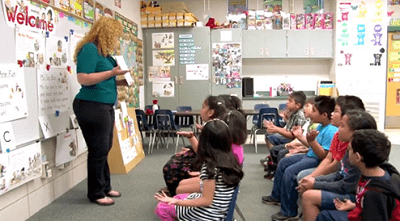Research has shown that there are many benefits to being able to speak more than one language. Learning multiple languages challenges the brain and improves cognitive and social-emotional development, learning, and the chances for long-term success.

The US Department of Education put together an informative document on the benefits of being bilingual and biliterate. In it they explain that bilingual people and children:
- Have an easier time: learning other languages, thinking about language, developing strong thinking skills, and growing in other areas of cognitive development.
- Benefit academically: they are able to switch between languages, helping them develop a more flexible approach to problem solving. It was also noted that, “The ability to read and think in two (or more) different languages promotes higher levels of abstract thought, which is important in learning.”
- Diversify society by using their second language to build friendships.
- Have more job opportunities than monolingual adults.
These aren’t the only benefits. With a strong foundation in their native language, children can apply what they know of learning to read to the second (or third, and so on) language, enhancing their literacy abilities and allowing them to “increase the rate at which they read comfortably…” in the new language. In school, children who speak more than one language usually get better grades and quickly build confidence as they become more competent in the second language. And because young children are able to mimic sounds, words, and phrases so well (be careful what you say in front of a 3-year-old because, chances are, you will hear it again!), they often are able to sound like a native speaker of the language! This is something that adults learning a second language might never be able to accomplish.
Stephen Krashen, a respected linguist and promoter of bilingual education and second-language acquisition, believes there are two important ingredients for teaching a second language to school-aged children. He explains during an interview for Language Magazine, “We need to provide students with a great deal of comprehensible input, the essential ingredient in language acquisition. Several decades of research has confirmed that we acquire language when we understand what we read or what we hear. This means filling the classroom hour with aural comprehensible input and making sure students establish a pleasure reading habit in the second language. It is crucial that the input be not only interesting, but compelling; so interesting that students forget it is in a second language. The second ingredient is making sure students know how language is acquired, so that they can continue to improve in the language after the course is over, and acquire other languages.”
GrapeSEED was developed, in part, based on Krashen’s beliefs. English learning lessons are taught so that children can gain an understanding of each new vocabulary word before they are expected to use it. Images are used often to help children associate words with the pictures. Teachers are encouraged to ask open-ended questions to engage the children and help them make connections between the words or activity and their own lives, expanding their comprehension of the language. With the comprehensible input used in the GrapeSEED classroom, children are not only acquiring the language, but they are quickly reaching proficiency, and in some cases, reaching it faster than the national average!





